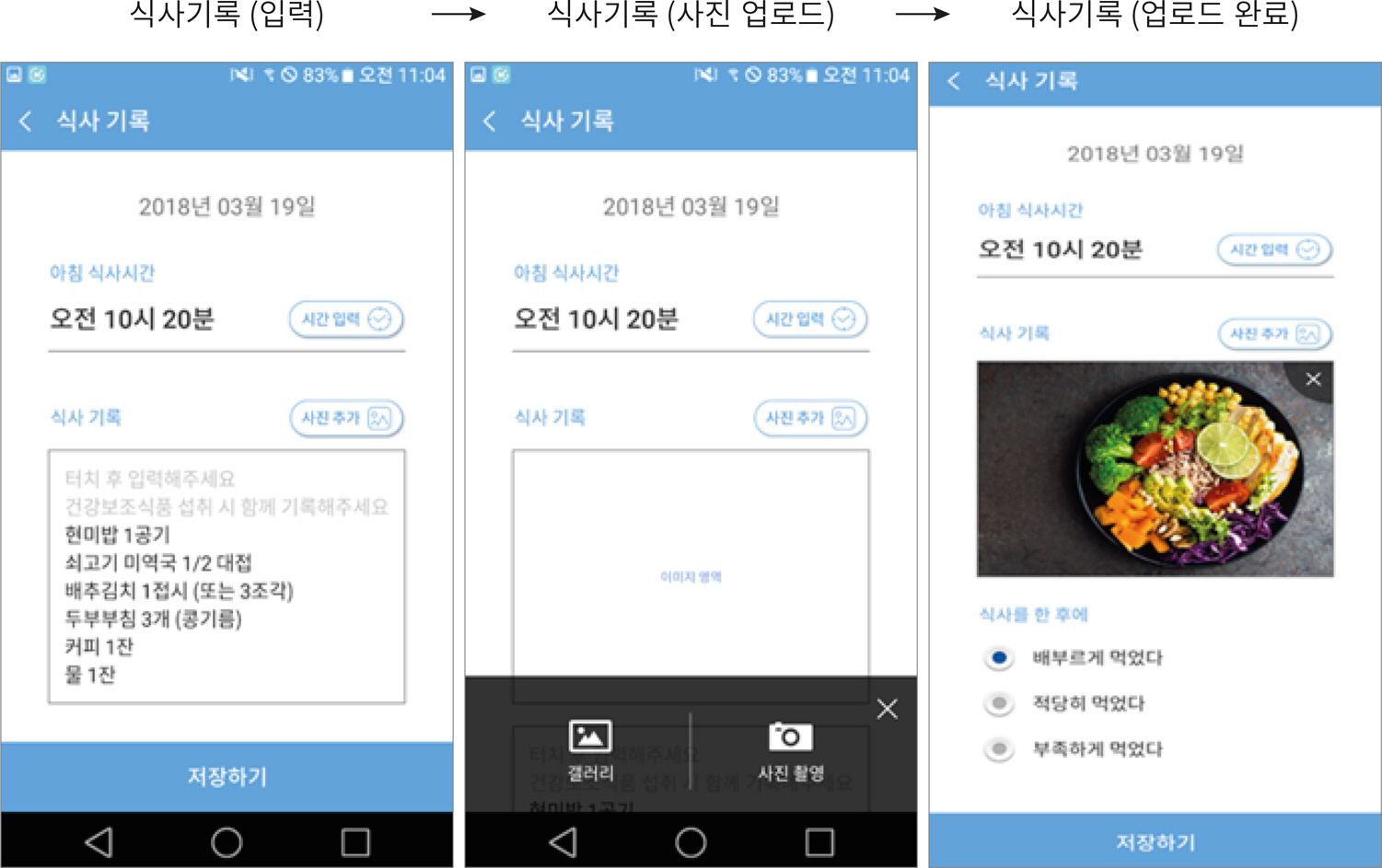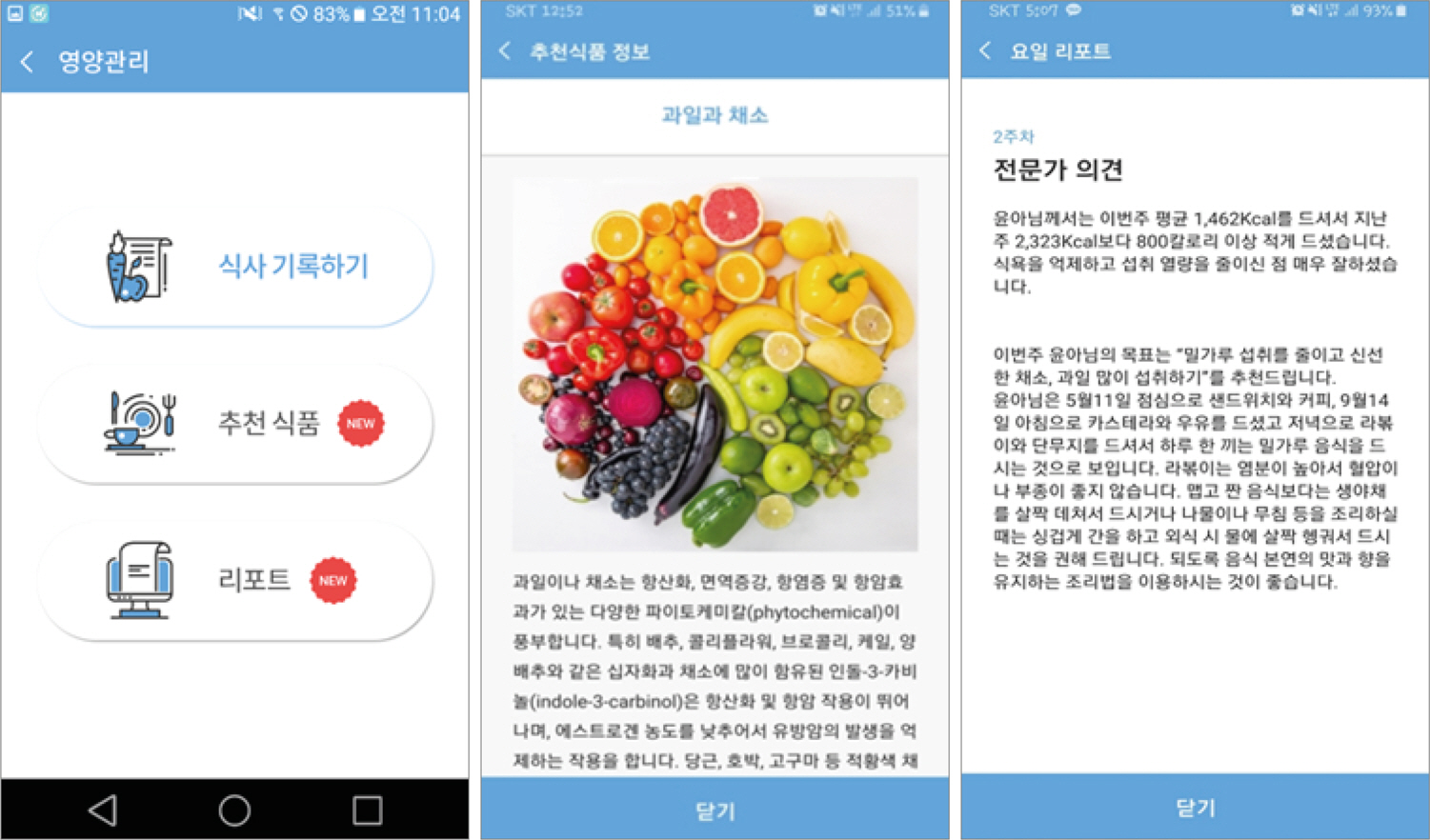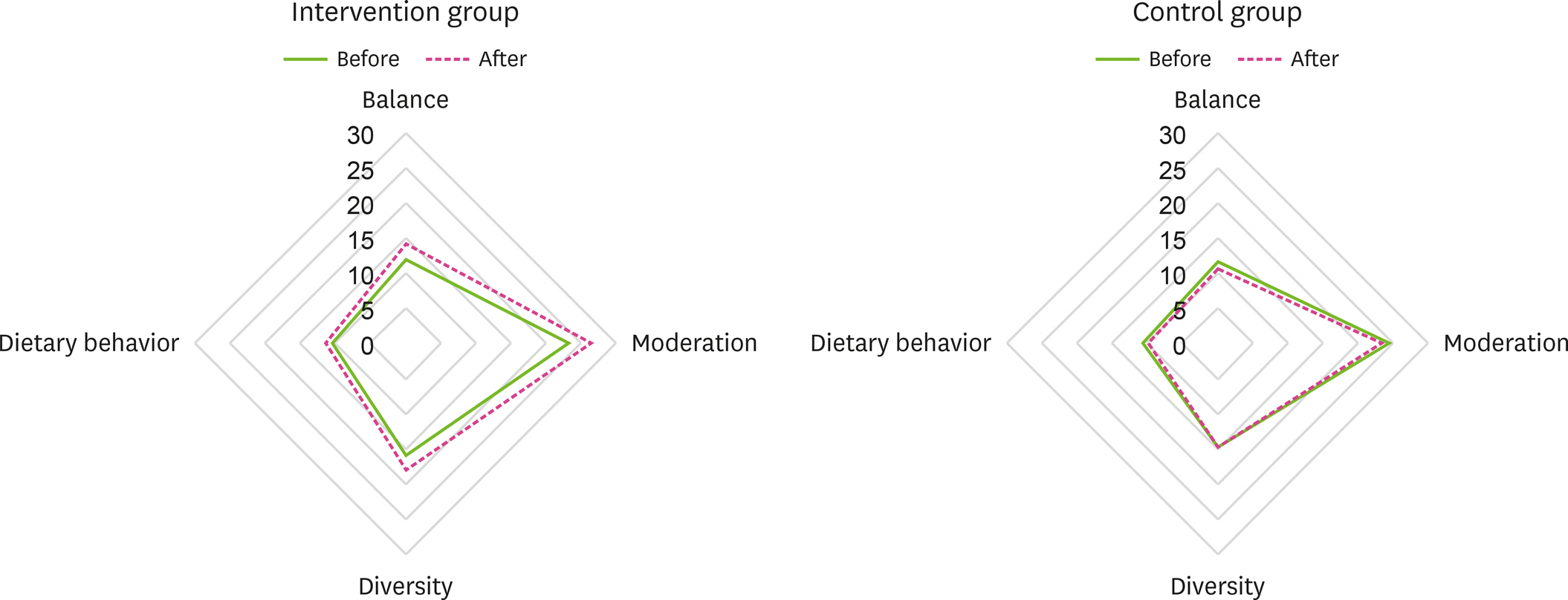J Nutr Health.
2020 Feb;53(1):83-97. 10.4163/jnh.2020.53.1.83.
Application and evaluation of mobile nutrition management service for breast cancer patients
- Affiliations
-
- 1Department of Food and Nutrition, Gachon University, Seongnam 13120, Korea. skysea@gachon.ac.kr
- 2LifeSemantics, Seoul 06138, Korea.
- KMID: 2471124
- DOI: http://doi.org/10.4163/jnh.2020.53.1.83
Abstract
- PURPOSE
This study evaluated the effects of nutrition management application in a mobile device on obesity management of patients with breast cancer.
METHODS
Fifty subjects, who were breast cancer survivors, aged 30 years and older, participated in an obesity management program for four weeks. They were divided randomly into two groups: a control group (n = 25) and a treatment group (n = 25). The treatment group was provided an application for nutrition management and diet consultant, while the control group maintained their ordinary life without any nutrition management.
RESULTS
The weight of the treatment group decreased by 0.8 kg, but the change was not significant. In contrast, the waist-hip ratio of the treatment group decreased significantly from 0.75 to 0.71 (p = 0.012). The Nutrition Quotients of the treatment group increased significantly from 61.3 to 69.6 points (p < 0.001), whereas that of the control group decreased significantly from 61.5 to 59.0 (p = 0.002).
CONCLUSION
This mobile nutrition management application for breast cancer patients is effective in managing obesity and dietary habits. These results can be used as basic information to prepare an obesity management program for breast cancer patients.
MeSH Terms
Figure
Cited by 1 articles
-
The development of a lifestyle modification mobile application, “Health for You” for overweight and obese breast cancer survivors in Korea
Su-Jin Seo, Ju-Hee Nho, Youngsam Park
Korean J Women Health Nurs. 2021;27(3):243-255. doi: 10.4069/kjwhn.2021.09.14.
Reference
-
References
1. Hooper L, Anderson AS, Birch J, Forster AS, Rosenberg G, Bauld L, et al. Public awareness and healthcare professional advice for obesity as a risk factor for cancer in the UK: a cross-sectional survey. J Public Health (Oxf). 2018; 40(4):797–805.
Article2. Protani M, Coory M, Martin JH. Effect of obesity on survival of women with breast cancer: systematic review and metaanalysis. Breast Cancer Res Treat. 2010; 123(3):627–635.
Article3. Dong Y, Zhou J, Zhu Y, Luo L, He T, Hu H, et al. Abdominal obesity and colorectal cancer risk: systematic review and metaanalysis of prospective studies. Biosci Rep. 2017; 37(6):BSR20170945.
Article4. Du X, Hidayat K, Shi BM. Abdominal obesity and gastroesophageal cancer risk: systematic review and metaanalysis of prospective studies. Biosci Rep. 2017; 37(3):BSR20160474.
Article5. Hidayat K, Du X, Chen G, Shi M, Shi B. Abdominal obesity and lung cancer risk: systematic review and metaanalysis of prospective studies. Nutrients. 2016; 8(12):E810.
Article6. Majumder K, Gupta A, Arora N, Singh PP, Singh S. Premorbid obesity and mortality in patients with pancreatic cancer: a systematic review and metaanalysis. Clin Gastroenterol Hepatol. 2016; 14(3):355–368.
Article7. Schwedhelm C, Boeing H, Hoffmann G, Aleksandrova K, Schwingshackl L. Effect of diet on mortality and cancer recurrence among cancer survivors: a systematic review and metaanalysis of cohort studies. Nutr Rev. 2016; 74(12):737–748.
Article8. Engin A. Obesity-associated breast cancer: analysis of risk factors. Adv Exp Med Biol. 2017; 960:571–606.
Article9. Rock CL, Doyle C, Demark-Wahnefried W, Meyerhardt J, Courneya KS, Schwartz AL, et al. Nutrition and physical activity guidelines for cancer survivors. CA Cancer J Clin. 2012; 62(4):243–274.
Article10. Copson ER, Cutress RI, Maishman T, Eccles BK, Gerty S, Stanton L, et al. Obesity and the outcome of young breast cancer patients in the UK: the POSH study. Ann Oncol. 2015; 26(1):101–112.
Article11. Winkels RM, Sturgeon KM, Kallan MJ, Dean LT, Zhang Z, Evangelisti M, et al. The women in steady exercise research (WISER) survivor trial: the innovative transdisciplinary design of a randomized controlled trial of exercise and weight-loss interventions among breast cancer survivors with lymphedema. Contemp Clin Trials. 2017; 61:63–72.
Article12. Swisher AK, Abraham J, Bonner D, Gilleland D, Hobbs G, Kurian S, et al. Exercise and dietary advice intervention for survivors of triple-negative breast cancer: effects on body fat, physical function, quality of life, and adipokine profile. Support Care Cancer. 2015; 23(10):2995–3003.
Article13. Seo JS, Park HA, Kang JH, Kim KW, Cho YG, Hur YI, et al. Obesity and obesity-related lifestyles of Korean breast cancer survivors. Korean J Health Promot. 2014; 14(3):93–102.
Article14. Song S, Youn J, Park M, Hwang E, Moon HG, Noh DY, et al. The association between the adherence to dietary guidelines for breast cancer survivors and health-related quality of life among Korean breast cancer survivors. Korean J Community Nutr. 2015; 20(2):129–140.
Article15. Schoeppe S, Alley S, Van Lippevelde W, Bray NA, Williams SL, Duncan MJ, et al. Efficacy of interventions that use apps to improve diet, physical activity and sedentary behaviour: a systematic review. Int J Behav Nutr Phys Act. 2016; 13(1):127.
Article16. Lee KM, Park JS, Kim HM, Kang SA. Nutritional intervention for dietary behavior modification in breast cancer patients. J Korea Acad Ind Coop Soc. 2018; 19(5):444–450.18. Park G, Lee H, Kim HY. The effects of utilizing smartphone application peer support on health behavior and body mass index among breast cancer survivors. J Korean Acad Nurs. 2019; 49(5):550–561.
Article19. Chae MY, Kim SI. A study of one-to-one custom application for breast cancer patient: focusing on service design methods. J Digit Converg. 2017; 15(7):367–373.20. Lee JS, Kim HY, Hwang JY, Kwon SH, Chung HR, Kwak TK, et al. Development of nutrition quotient for Korean adults: item selection and validation of factor structure. J Nutr Health. 2018; 51(4):340–356.
Article21. Park JY, Kim NH, Kang SH. Analysis of physical activity measured by international physical activity questionnaire and actigraph accelerometer, and participation intention for physical activity of breast cancer survivors. J Korean Biol Nurs Sci. 2015; 17(2):104–113.
Article22. Hadzi-Pavlovic D, Hickie IB, Wilson AJ, Davenport TA, Lloyd AR, Wakefield D. Screening for prolonged fatigue syndromes: validation of the SOFA scale. Soc Psychiatry Psychiatr Epidemiol. 2000; 35(10):471–479.
Article23. Kim S, Bae WK, Kim JY, Jang M, Kim JH, Noh HH. Validation of the Korean Version of Schedule of Fatigue and Anergia: General Physician Questionnaire. J Korean Med Sci. 2016; 31(2):159–163.
Article24. Kim YW, Sung GD, Baek YK. Effect of 12 weeks combined exercise and nutrition education on body composition and metabolic syndrome in breast cancer patients. J Korean Soc Living Environ Syst. 2013; 20(1):1–9.25. Ewertz M, Jensen MB, Gunnarsdóttir KÁ, Højris I, Jakobsen EH, Nielsen D, et al. Effect of obesity on prognosis after early-stage breast cancer. J Clin Oncol. 2011; 29(1):25–31.
Article26. Chan DS, Vieira AR, Aune D, Bandera EV, Greenwood DC, McTiernan A, et al. Body mass index and survival in women with breast cancer-systematic literature review and metaanalysis of 82 follow-up studies. Ann Oncol. 2014; 25(10):1901–1914.
Article27. Lee CM, Lee JH, Moon DC. The effect of exercise intervention program in breast cancer patients: a systematic review and metaanalysis. J Korea Soc Wellness. 2015; 10(4):341–354.28. Byar KL, Berger AM, Bakken SL, Cetak MA. Impact of adjuvant breast cancer chemotherapy on fatigue, other symptoms, and quality of life. Oncol Nurs Forum. 2006; 33(1):E18–E26.
Article29. Mefferd K, Nichols JF, Pakiz B, Rock CL. A cognitive behavioral therapy intervention to promote weight loss improves body composition and blood lipid profiles among overweight breast cancer survivors. Breast Cancer Res Treat. 2007; 104(2):145–152.
Article30. Demark-Wahnefried W, Case LD, Blackwell K, Marcom PK, Kraus W, Aziz N, et al. Results of a diet/exercise feasibility trial to prevent adverse body composition change in breast cancer patients on adjuvant chemotherapy. Clin Breast Cancer. 2008; 8(1):70–79.
Article31. Goodwin PJ, Segal RJ, Vallis M, Ligibel JA, Pond GR, Robidoux A, et al. Randomized trial of a telephone-based weight loss intervention in postmenopausal women with breast cancer receiving letrozole: the LISA trial. J Clin Oncol. 2014; 32(21):2231–2239.
Article32. Chung BY, Oh EH. The effect of diet intervention in breast cancer: a metaanalysis. Asian Oncol Nurs. 2017; 17(1):1–11.
Article33. Chung BY, Oh EH, Song SJ. Mobile health for breast cancer patients: a systematic review. Asian Oncol Nurs. 2017; 17(3):133–142.
Article34. Ashman AM, Collins CE, Brown LJ, Rae KM, Rollo ME. Validation of a smartphone image-based dietary assessment method for pregnant women. Nutrients. 2017; 9(1):E73.
Article35. Yang Y, Jia W, Bucher T, Zhang H, Sun M. Image-based food portion size estimation using a smartphone without a fiducial marker. Public Health Nutr. 2019; 22(7):1180–1192.
Article36. Ahn JS, Song S, Moon SE, Kim S, Lee JE. The perception of laymen and experts toward mobile applications for self-monitoring of diet based on in-depth interviews and focus group interviews. Korean J Community Nutr. 2018; 23(3):202–215.
Article37. Mezgec S, Koroušić Seljak B. NutriNet: a deep learning food and drink image recognition system for dietary assessment. Nutrients. 2017; 9(7):E657.
Article38. Zhang W, Yu Q, Siddiquie B, Divakaran A, Sawhney H. Snap-n-Eat: food recognition and nutrition estimation on a smartphone. J Diabetes Sci Technol. 2015; 9(3):525–533.39. Lo FP, Sun Y, Qiu J, Lo B. Food volume estimation based on deep learning view synthesis from a single depth map. Nutrients. 2018; 10(12):E2005.
Article
- Full Text Links
- Actions
-
Cited
- CITED
-
- Close
- Share
- Similar articles
-
- Mobile Health for Breast Cancer Patients: A Systematic Review
- The development of a lifestyle modification mobile application, “Health for You” for overweight and obese breast cancer survivors in Korea
- FIT4PEDON: Mobile Nutrition Counseling Application Effectiveness and Usability for Childhood Cancer Survivors
- Development and Evaluation of Nutrition Education Media for Breast Cancer
- Diabetes Management via a Mobile Application: a Case Report




